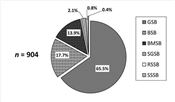|
Colonization Of Western Kentucky By Brown Marmorated Stink Bug
DR. RAUL T. VILLANUEVA AND DR. ZENAIDA VILORIA
PRINCETON, KY.
Halymorpha halys (Hemiptera: Pentatomidae) known as brown marmorated stink bug (BMSB), is a polyphagous invasive species of Asian origin that feeds on more than 100 plant species in the U.S. Initially, BMSB was found in Pennsylvania around the mid-90s; nowadays it has established populations in many areas of the mid-Atlantic states of the U.S. However, BMSB overwinters in large population aggregations inside human dwellings and are “skilled” hitchhikers; these two conditions make their dispersal easily achievable (i.e. using vehicles for dispersal), thus, they have now been reported in most states in the U.S.
In Kentucky, BMSB were first reported in 2010, and since then, it has established population affecting vegetables or fruit in most central and eastern counties. Although BMSB has been reported in many western counties (likely hitchhikers), overwintering BMSB populations and tallies in soybean fields resulted in nil counts in most western counties (west of Hardin County) since 2016 up until 2018. After that, a graduate student (Yaziri Gonzalez) found one specimen in a pheromone trap in the Research and Education Center (REC) at Princeton; and several specimens in McLean, Henderson, and Daviess counties in 2019.
Scouting Results in 2020
In 2020, tallies completed in western Kentucky during the last week of August and first 3 weeks of September resulted in the capture of BMSB in 17 out of 19 counties (Figure 1). Tallies were conducted in 29 commercial soybean fields and three research sites at the REC using sweep nets. This outcome may show a geographical expansion of BMSB colonization of western Kentucky. BMSB might have been in this area but in undetectable population levels, and its absentia can be demonstrated by the lack of reports of BMSB aggregation in human dwellings in these counties. The presence of BMSB may be temporary (although this possibility is minimal); however, in 2020 BMSB populations are exploding for unknown reasons. This may make 2020 a “good year” for a complex of stink bugs (Figure 2), or perhaps the colonization took all this time as it occurred in eastern Kentucky. In a previous report published in KPN, data were presented in the surpasing of economic thresholds by the complex of stink bugs in soybeans. All of these hypotheses and phenomena may need to be re-evalauated during the coming months. Studies will be conducted regarding their agregation in houses or storage areas, and their presence on diverse crop systems.
From a total of 904 specimens tallied during the scouting described above, the green stink bug Chinavia hilaris was the most abundant (65.5 percent), followed by the brown stint bug Euschistus spp. (17.7 percent), BMSB (13.9 percent), southern green stink bug Nezara viridula (2.1 percent), redshouldered stink bug (0.8 percent) and the predacious spined soldier stink bug Podisus maculeventris (0.4 percent) (Figure 3). These results on BMSB populations may be inflated; if data from the three most central counties (Henderson, McLean, and Daviess) are removed, the number of stink bug specimens are reduced to 775 and the percentages of BMSB are only 6.2 percent, and from all the 126 BMSB specimens collected, only a handful were adults while the rest were nymphs. These conditions may be a signal that BMSB is expanding in western Kentucky.
Management
Two main recommendations for the management of BMSB have resulted from these findings:
• BMSB can start to become an unwelcome host in western Kentucky homes during the winter. As the Asian ladybug Harmonia axyridis, BMSB will enter poorly sealed structures and aggregate in sheltered areas. This causes staining on walls, a foul smell, and can cause allergies. Repair to screens and sealing holes in structures is needed to avoid aggregations.
• In agriculture, insecticides can be used to reduce stink bug populations, however, it is known that BMSB is more resistant to insecticides than other endemic species (green stink bug or brown stink bug); therefore insecticides should be used to target immature stages that are more susceptible, rather than adult stages. ∆
DR. RAUL T. VILLANUEVA: Entomology Extension Specialist, University of Kentucky
DR. ZENAIDA VILORIA: Entomology Research Analyst, University of Kentucky

Figure 1. Counties where brown marmorated stink bugs were found in commercial soybean fields of western Kentucky in
2019 and 2020. Yellow: BMSB found in 2019 and 2020; purple: BMSB not found in 2020, light-blue: BMSB found in 2020
and absent in 2019, and white: counties not scouted.
 Figure 2. Adult stink bug species detected in commercial soybean fields of Kentucky. (a) Brown stink bug, Figure 2. Adult stink bug species detected in commercial soybean fields of Kentucky. (a) Brown stink bug,
(b) Green stink bug,
(c) Spined soldier stink bug, and
(d) Brown marmorated stink bug.
Photo: Raul T. Villanueva, UK

Figure 3. Percentages of six stink bug species (GSB=green stink bug. BSB, brown stink bug, BMSB=brown marmaorated
stink bug, SGSB=southern green stink bug, RSSB=red shouldered stink bug, and SSSB=spined soldier stink bug) tallied in 29 commercial fields in 19 counties, and 3 sites at the Research and Education Center-Princeton. Tallies were completed using sweep nets during the last week of August and first 3 weeks of September.
|
|